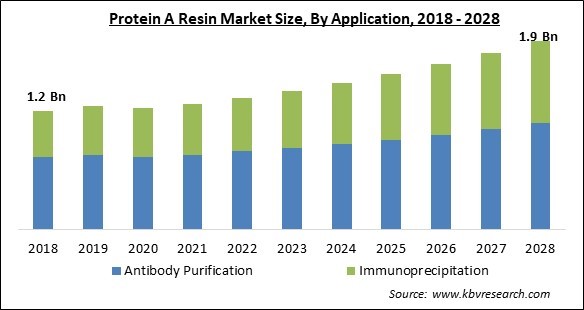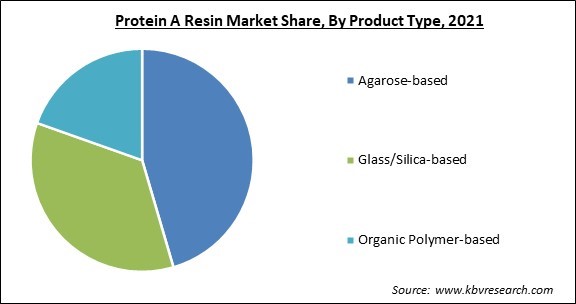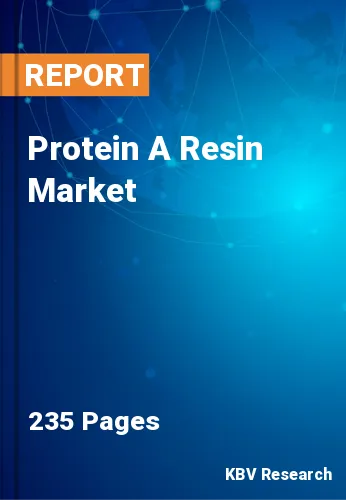The Global Protein A Resin Market size is expected to reach $1.9 billion by 2028, rising at a market growth of 6.1% CAGR during the forecast period.
Protein A Resin is an affinity chromatography medium developed for one-step purification of classes, easy, fragments, and sub-classes of immunoglobulin from cell culture media and biological fluids. It could be utilized for protein complexes, antigens, or immunoprecipitation of proteins. The recombinant protein A ligand is combined with agarose.

The combining is maximized to provide a high tying ability for immunoglobulin. The static tying ability of Protein A Resin is more than 20 mg human IgG/ml fixed resin. The dynamic tying ability varies depending on specific factors like target antibody, flow rate, etc. Protein A is a bacterial cell wall protein distant from Staphylococcus aureus that merges with mammals primarily via the Fc region.
Native protein A has five IgG binding sections and several sections with undetermined roles. Recombinant protein A comprises five high-affinity IgG binding sections with other unnecessary domains detached to decrease nonspecific binding. It includes five immunoglobulin-tying sections, each of which can tie the proteins from several mammal species, most significantly IgG (Immunoglobulin G) by the heavy tie inside the Fc region.
These are the most often utilized affinity resins in biomanufacturing. Increasing emphasis on drug evolution by pharmaceutical & biotechnology and growing investment in synthetic biology industries would drive the market’s growth. The biopharmaceutical businesses are widely utilizing protein-engineered products in its research activities to expand a wide variety of protein-based drugs.
Progress of drug discovery & therapeutics needs proper understanding and analysis of the role and structure of protein resins in combating SARS-CoV-2 virus. Altough, the enforced lockdown, the closing of the research institutions became an obstruction to the research analysis. Moreover, several planned measures have been enforced by leading players to develop mAbs to treat COVID-19 patients. Thus, biotechnology & biopharmaceutical businesses are also involved in mergers & collaboration for the growth of vaccines used in treating COVID-19 patients. As protein A resin is needed for purification of antibodies, the increasing production of mAb as a measure to tackle pandemic is predicted to positively affect the market in the pandemic period.
Chromatography is a crucial measure in the purification of mAbs (monoclonal antibodies). Consequently, there has been an immense demand for monoclonal antibodies in oncology and other medicinal sectors, comprising autoimmune, inflammatory and neurological diseases. Due to this, nearly all significant pharmaceutical businesses are concentrating on the research & development of medicinal antibodies. The increasing demand for medicinal antibodies has significantly accelerated the growth of the protein A resin market.
A growing number of CMOs & CROs are providing their facilities to pharmaceutical industries worldwide. This is anticipated to offer potential development chances to protein A resin producers throughout the predicted period. Pharmaceutical businesses are progressively depending on contract producers in several research fields to attain essential needs, like cost reduction and specialized competencies. The pharmaceutical CMOs have accomplished robust development in recent years, and this tendency is anticipated to pursue in the upcoming years. Furthermore, the growing pressure from various governments to decrease healthcare rates and decrease R&D efficiency has forced the main pharmaceutical manufacturers to depend on CMOs. This serves as an important factor for the growth of the protein A resins market.
Protein A resin's cost is about 5 to 10 times higher than any other resin. Although no other method could attain a purification degree as high as protein A resins, their high cost makes customers seek alternatives. A few methods offer an acceptable degree of purification that comprises both non-chromatography and chromatography techniques. PEG (polyethylene glycol) precipitation & mAb crystallization are being researched as other methods for protein A chromatography. The influence of this preventing factor is more apparent in developing markets like Latin America and the Asia Pacific. This may result in the growth of protein A resin market over the course of projection period.
Based on the type, the protein A resin market is divided into natural and recombinant. In 2021, the natural segment garnered a significant revenue share in the protein A resin market. For the purification of mAbs, the bacterial cell of the staphylococcus aureus species is derived and acquired. Besides, natural protein A resins have various uses in biomedical research for affinity chromatography, vaccine & therapeutics production and antibody purification. Furthermore, the sector is predicted to expand because of its capability to reduce the ligand draining procedure and stability issues with traditional natural protein A resins.

On the basis of product type, the protein A resin market is classified into agarose-based protein A, glass/silica-based protein A and organic polymer-based protein A. In 2021, the organic polymer-based protein A segment registered a substantial revenue share in the protein A resin market. This is credited to its large and fast molecule detachment effects. In addition, they have high biodegradability & biocompatibility, comprising a wide variety of usages in biosensors, imaging, bio-separation and drug delivery.
By application type, the protein A resin market is bifurcated into antibody purification and immunoprecipitation. In 2021, the antibody purification segment witnessed the highest revenue share in the protein A resin market. There has been a consistent demand for mAbs for research, industrial purpose, and therapeutic production. Antibody purification involves the enrichment and isolation of antibodies from ascites fluids, cell culture supernatant of mAbs and polyclonal Abs.
Based on the end-use type, the protein A resin market is classified into pharmaceutical & biopharmaceutical companies, academic research institutes and others. In 2021, the pharmaceutical & biopharmaceutical companies segment held the highest revenue share in the protein A resin market. The growing usage of protein A resins in mAbs, drug discovery, therapeutics and vaccine production processes in biopharmaceutical production, and the increasing utilization of constant production procedures are factors responsible for protein A resin.
| Report Attribute | Details |
|---|---|
| Market size value in 2021 | USD 1.3 Billion |
| Market size forecast in 2028 | USD 1.9 Billion |
| Base Year | 2021 |
| Historical Period | 2018 to 2020 |
| Forecast Period | 2022 to 2028 |
| Revenue Growth Rate | CAGR of 6.1% from 2022 to 2028 |
| Number of Pages | 235 |
| Number of Tables | 420 |
| Report coverage | Market Trends, Revenue Estimation and Forecast, Segmentation Analysis, Regional and Country Breakdown, Companies Strategic Developments, Company Profiling |
| Segments covered | Product Type, Type, Application, End-use, Region |
| Country scope | US, Canada, Mexico, Germany, UK, France, Russia, Spain, Italy, China, Japan, India, South Korea, Singapore, Malaysia, Brazil, Argentina, UAE, Saudi Arabia, South Africa, Nigeria |
| Growth Drivers |
|
| Restraints |
|
Region-wise, the protein A resin market is analysed across North America, Europe, Asia Pacific and LAMEA. In 2021, the North America region led the protein A resin market by generating the largest revenue share. This is because of the growing demand for protein-based remedies for curing contagious diseases and the increasing amount of FDA-approved biotechnology and pharmaceutical businesses in this region. Furthermore, there is a growth in the number of mergers, acquisitions and collaborations between the main players that drive the market's growth.
Free Valuable Insights: Global Protein A Resin Market size to reach USD 1.9 Billion by 2028
The market research report covers the analysis of key stake holders of the market. Key companies profiled in the report include General Electric (GE) Co. (GE Healthcare), Repligen Corporation, PerkinElmer, Inc, Thermo Fisher Scientific, Inc., Merck Millipore (Merck Group), Genscript Biotech Corporation, Agilent Technologies, Inc., Abcam plc, and Novasep Holdings SAS (Azulis Capital).
By Product Type
By End Use
By Type
By Application
By Geography
The global Protein A Resin Market size is expected to reach $1.9 billion by 2028.
Increasing demand for medicinal antibodies are driving the market in coming years, however, High cost associated with resins restraints the growth of the market.
General Electric (GE) Co. (GE Healthcare), Repligen Corporation, PerkinElmer, Inc, Thermo Fisher Scientific, Inc., Merck Millipore (Merck Group), Genscript Biotech Corporation, Agilent Technologies, Inc., Abcam plc, and Novasep Holdings SAS (Azulis Capital).
The Agarose-based segment acquired maximum revenue share in the Global Protein A Resin Market by Product Type 2021 thereby, achieving a market value of $840 million by 2028.
The Recombinant segment is leading the Global Protein A Resin Market by Type 2021 thereby, achieving a market value of $1,000 million by 2028.
The North America market dominated the Global Protein A Resin Market by Region 2021, and would continue to be a dominant market till 2028; thereby, achieving a market value of $755.7 million by 2028.
Our team of dedicated experts can provide you with attractive expansion opportunities for your business.

